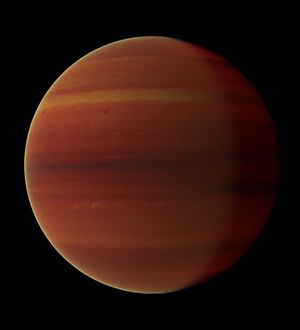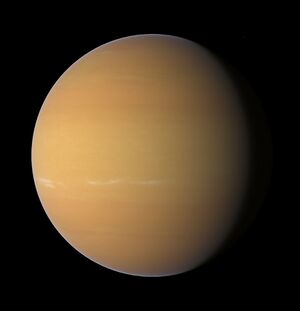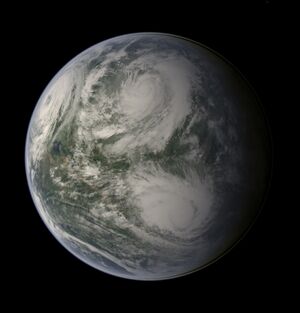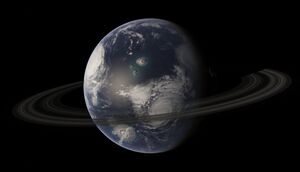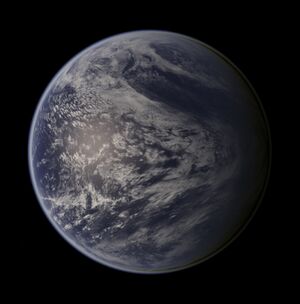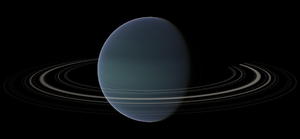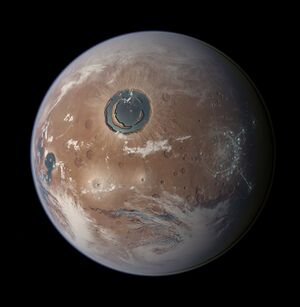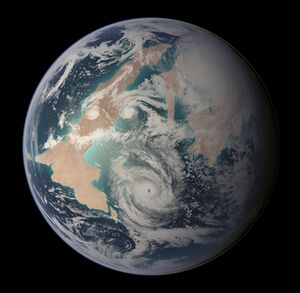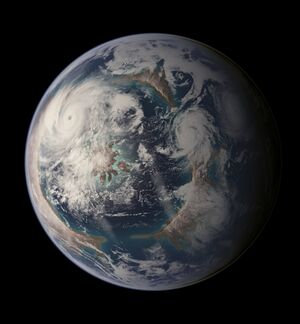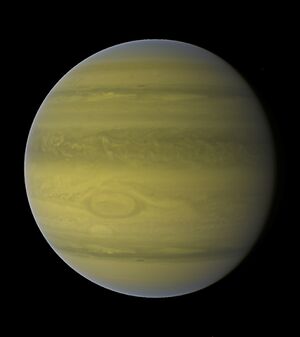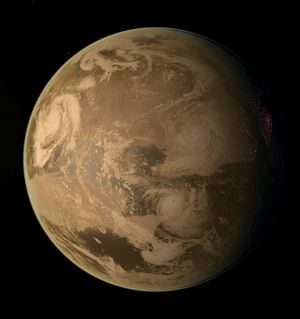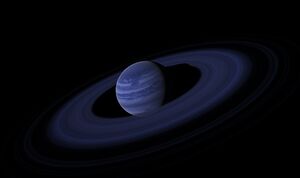Salia System
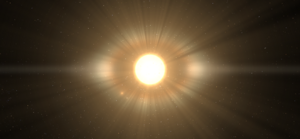 | |
| Age | ~3.5 billion years |
|---|---|
| Location | Orion Arm, Milky Way Galaxy |
| Nearest star | AX Microscopii (4.33 ly) |
| Nearest known planetary system | Gliese 887 (4.7234 ly) |
| Planetary system | |
| Semi-major axis of outer known planet | TBA |
Populations | |
| Known stars | 3 (Salia, Amir, Hassan) |
| Known planets |
Salia: 8 (2 terrestrial planets, 6 gas giants) Amir: 4 (4 terrestrial planets) Hassan: 6 (5 terrestrial planets, 1 gas giant) |
| Known dwarf planets | 6 (known) |
| Star-related properties | |
| Spectral type |
Salia: K5V Amir: T1V Hassan: T6V |
The Salia System is a triple star system located approximately 12 light-years from the Sun and 25.13 light-years from the Ingffhaestian System. The system is known to humans as Epsilon Indi and contains three main gravitational centers: the K-type star Salia and the binary brown dwarfs Amir and Hassan. Amir and Hassan orbit approximately 1460 AU away from Salia.
As a whole, the Salia System contains 18 planets, all in S-type orbits: 8 planets orbit Salia, 4 planets orbit Amir, and 6 planets orbit Hassan. Prior to contact with the Uingffhians, the humans had only discovered one of these planets: the gas giant Pronos, or Epsilon Indi Ab. Like most multiple star systems, the Salia System lacks substantial subplanetary objects such as comets, dwarf planets, and asteroids due to gravitational interactions between the system's stellar and substellar objects.
The Salia System was first visited and colonized by the Kingdom of Kerolon. Under Kerolon, the main Salia System became a thriving colony populated mostly by individuals native to Uingffh, but also by some people from other worlds and star systems. Meanwhile, however, the Amir and Hassan systems remained rather unpopulated due to their highly unusual environments as brown dwarf systems. This would change in late 2018, when the discovery of a number of valuable materials on the Amirian and Hassanian worlds prompted the Unified States of Osuwa and the Great Morbidian Hegemony to desire control of Amir and Hassan, which Kerolon was willing to give away due to having plenty of its own resource-rich systems. However, disputes between Osuwa and Morbidia over the two brown dwarfs grew heated. They culminated in the Battle of Bor and the subsequent Fall of Ojas and Avalon Stations, which severely devastated the surface of the fourth planet Bor (a populated Kerolonian colony) and injured 12th Kerolonian Princess Nisc Elizer Kerolon and her Tristanian escort Carter Citadel.
Composition
The primary component of the Salia System is Salia itself, a low-mass K-type main sequence star making up the vast majority of the system's mass. All other objects in the Salia System orbit Salia in some fashion. However, Salia's two brown dwarf companions - Amir and Hassan - also have significant mass and exert significant gravitational influence, albeit not as much as a true companion star.
All three stellar/substellar components of the Salia System are chiefly composed of hydrogen and helium, as are the giant planets of the system. Meanwhile, the smaller terrestrial planets and inner moons are composed of rocky materials such as iron or nickel. Terrestrial bodies in higher orbits around Salia, such as dwarf planets or comets, have icier compositions. These compositions are all consistent with the typical system trend of inner planets being composed of materials with lower melting points and outer planets being composed of materials with higher melting points.
The Salia System follows the Solar System's layout to some degree, with lighter planets orbiting closer and the largest giant planets orbiting outwards. However, the presence of two hot super-neptunes - Onaut and Nyoope - in the inner system notably breaks this trend. Compared to the Solar System, the Salia System contains less minor icy objects like comets or dwarf planets, which can be attributed to gravitational interference from Amir and Hassan.
Orbits
Like the Earth's Solar System, most objects in the Salia System all orbit in circular paths on the same plane, or elliptic, while smaller minor bodies such as dwarf planets, asteroids, and comets tend to have more erratic, eccentric, and inclined orbits compared to those of the planets. Minor bodies are slightly lower than usual in number due to the influence of Amir and Hassan on the Salian Oort Cloud; the bodies that do exist tend to have even more unusual orbits than many of Earth's minor bodies for the same reason described prior. Many of Salia's larger planets bear host to large systems of moons, with many of them being tidally locked to their parent planets.
Two notable exceptions to the first aforementioned trend exist in the Salia System, however: Pronos and Seidon. Both giant planets follow orbits exhibiting noticeably high inclinations relative to the Salian elliptic. Some Ingffhaestian astronomers attribute this to Salia's younger age, postulating that Pronos and Seidon's orbits would come to align with the rest of the planets' orbits with time. Others theorize that Pronos and Seidon were captured rogue planets, though the near-circular shapes of their orbits and their consistent age with the rest of the system's objects challenge such notions.
Most objects in the Ingffhaestian Star System's three component planetary systems orbit in the same direction as Ingffhaestia's rotation (which is counterclockwise) while moons do the same, but with their parent planet. Exceptions to both cases exist and are much more common in small, minor objects like comets, though a few large moons have retrograde orbits.
Formation and evolution
Roughly 3.5 billion years ago, the Salia System formed in similarly to other star systems, beginning as a molecular cloud floating in deep space. According to measurements of Salia's metallicity, Salia's molecular cloud likely contained roughly the same amount of elements heavier than hydrogen and helium as the Sun's molecular cloud did.
The molecular clouds then condensed due to gravity until several protoplanetary disks formed with protostars in their centers. Numerous giant planets formed in Salia's protoplanetary disk; it is commonly accepted that the inner giant planets - Onaut, Nyoope, and Kit - all formed in more outer orbits, but then migrated inwards into their current orbits. Because of Onaut and Nyoope's relatively low mass compared to true hot jupiter exoplanets, the two super-neptunes still left enough material in the inner system to form the system's two large terrestrial planets, Helin and Bor.
Within around 50 million years after forming, the principal protostar of the system initiated nuclear fusion and became Salia, marking the beginning of its main sequence phase. However, the progenitor protostars of Amir and Hassan failed to accrete enough material to initiate the fusion of hydrogen atoms; thus, they became brown dwarf stars. By the time Salia, Amir, and Hassan had begun their main sequence phases, moons had begun to form around their planets. All three objects are still in their main sequence phases; Salia is expected to remain in the main sequence phase for at least another 20 billion years while Amir and Hassan will remain stable for untold eons.
Future
In 20-50 billion years, Salia will exhaust its core supply of hydrogen and begin fusing hydrogen in a shell near its surface, resulting in its expansion into a subgiant. However, increases in its luminosity would have likely rendered most presently habitable worlds uninhabitable before then. Not long afterwards, Salia will expand into a red giant star. This will likely result in the destructions of Onaut, Nyoope, and Helin; Bor also has a decent chance of being consumed by the expanding Salia. After Salia begins fusing helium in its core, it will contract back into a red clump star much smaller than a red giant, but still significantly larger than a main sequence star. A second expansion into a red giant (asymptotic giant branch) occurs afterward, possibly destroying Bor (if Salia's first red giant phase had not already destroyed it) and Kit, after which the star will gradually shed its outer layers into a planetary nebula and transition into a white dwarf star. It is theorized that Salia's remnants will then very slowly cool until becoming a black dwarf after quadrillions of years.
Amir and Hassan's futures are still uncertain due to the fact that the universe is not old enough to have witnessed the end of a brown dwarf's life. In fact, it is not clear whether brown dwarfs will every truly "die". Most astronomers theorize that Amir and Hassan will instead very gradually cool down over inconceivably long periods of time before fading away.
Major bodies
Salia
Salia is the central star of the Salia System and a main sequence star slightly smaller than the Sun, with ~75% of its mass and ~71% of its radius. Its spectral type is K5V, and its average temperature is 4649 Kelvin. Salia is the largest and most massive object in its stellar system, accounting for almost all of its mass.
Salia is notable for its strong similarities to Ingffhaestia, sharing numerous stellar properties such as class, temperature, size, and mass. Because of these shared traits, Salia is often considered an "Ingffhaestian Analog" star. Salia's only major difference is its age, being roughly 7.5 billion years younger than Ingffhaestia. Salia is assumed to remain on the main sequence for at least as long as Ingffhaestia, if not even longer.
A total of 8 planets orbit Salia.
Onaut
Onaut is the first planet of Salia's planetary system. The planet is considered a hot super-neptune; Onaut has a mass and radius larger than those of the Solar System's ice giants (albeit still significantly smaller than those of a gas giant) as well as an orbit that takes it exceedingly close to its parent star. The planet is hot enough for red bands of heat to manifest on its night side. Like most hot giant planets, Onaut is tidally locked, driving extreme winds within its turbulent atmosphere.
Onaut notably boasts a strong reddish hue. The causes of its color are still poorly understood, but temperature likely plays a significant role, with high temperatures resulting in a red glow from the planet's compounds.
Nyoope
Nyoope is Salia's second planet and another hot ice giant. In terms of mass and radius, Nyoope is almost identical to Onaut; however, Nyoope orbits much further out than its scorched cousin, resulting in its classification as a warm super-neptune. Nyoope orbits far enough from Salia to not suffer from tidal locking, though it still rotates much slower than most planets in higher orbits. This combined with Nyoope's lower temperature gives Nyoope a very calm atmosphere with relatively few storms and rather low winds, though the planet is not immune to severe weather or turbulence.
Nyoope displays a prominent yellow hue caused by extensive sulfur in its atmosphere. Additionally, the planet has much lower amounts of methane than most ice giants, strengthening the yellow hue (otherwise, Nyoope would have most likely developed a greenish hue from yellow sulfur and blue methane mixing).
Helin
Helin is the third planet of the Salia System and its first terrestrial planet. Helin is slightly smaller than the Earth in terms of radius and mass, and orbits in a similar orbital position to Venus.
Helin's environment is very warm and humid thanks to a thick, moist atmosphere, though the planet is far from hot enough to generate a runaway greenhouse effect and convert into a Venus-like world. Meanwhile, the surface mostly consists of low-lying land and shallow lakes, with mountainous areas and deep bodies of water being relatively rare due to the world's significantly less active plate tectonics. As a result, Helin has an overall environment resembling that of a planetwide swamp or jungle. The vast majority of the surface is covered in tropical plants/gramen unintentionally imported from Uingffh, which have adopted a dark green hue as an adaptation to Salia's dimmer, more orange sunlight.
A notably unusual trait of Helin is its tropical cyclones. Though the planet is predominantly land, the warm, humid atmospheric conditions allow for the formation of tropical cyclones via the brown ocean effect. Because these conditions are global, Helin's tropical cyclones can grow exceptionally large, sometimes covering a quarter of the planet. However, since the planet still lacks substantial oceans, these large tropical cyclones are limited in strength to around Category 2 on the Saffir-Simpson Scale. Nonetheless, more powerful tropical cyclones are known to occur on infrequent occasions.
Bor
Bor is Salia's fourth planet and its largest, being a super-Earth several times more massive than Earth. Like Helin, Bor orbits within the habitable zone of Salia and boasts liquid water and a breathable atmosphere. Most of the planet's surface is oceanic in nature, but large landmasses do exist in the form of volcanic island continents comprised of enormous shield volcanoes; due to Bor's lack of plate tectonics as a super-Earth, hotspots are allowed to develop large volcanoes similar to those found on Mars or Venus. Most Kerolonian settlements are resorts and cities built along these volcanoes' flanks. Bor is unique in that regard, as most super-Earths of its mass harbor no land whatsoever.
Bor is encircled by a dim but thick ring system. Most astronomers theorize that a powerful collision with a large planetoid resulted in their formation along with the creation of its moon Oca, similar to how Earth's moon formed. Additionally, some Ingffhaestian geologists and astronomers argue that the aforementioned impact resulted in increased geological activity that accounts for Bor's massive volcanic shields.
Bor is notable for being the site of the eponymous disastrous Battle of Bor in the Earth year 2018 AD, when disputes between the USO and Morbidia over control of Salia's brown dwarf companions Amir and Hassan escalated into an armed space conflict in low Bor orbit. The climax of this battle inadvertently damaged Ojas and Avalon Stations, a pair of O'Neill Cylinder colonies also in a low orbit around Bor, causing them to orbitally de-stabilize and fall onto Bor's surface. The resultant impacts devastated countless cities while generating megatsunamis that encircled the planet and brought further catastrophic damage to coastal colonies. An estimated 23 million people, including each of the stations' ~7-8 million inhabitants, perished during this catastrophe while even more millions were injured, including 12th princess of Kerolon Nisc Elizer Kerolon and her Tertanian escort. The Battle of Bor is said to have set off later events contributing to the fall of Osuwa, Morbidia, and Kerolon (particularly those concerning Urlum Eudae Kerolon, Nisc's older sister) and thus is considered the first of the 12 Great Calamities.
Oca
The moon Oca is the largest natural satellite of Bor and said planet's only atmospheric satellite. Oca is roughly twice the size of Earth's Moon and is substantially larger and more massive than Mercury; the object sits right on the threshold of being able to retain a thick atmosphere. Thanks to its orbit around the habitable Bor, Oca itself harbors habitable conditions, boasting liquid water and a breathable atmosphere. However, the entirety of the planet is covered in ocean; due to its lack of land, Oca is largely unsuitable for large-scale colonization by sentient life, with the moon's oceanic nature limiting signs civilization to small, scattered, usually unmanned scientific outposts.
Most astronomers agree that Oca formed in a similar manner to Earth's moon, forming from gravitationally-attracted debris thrown out by a massive planetary collision involving Bor. This same impact also triggered the formation of Bor's rings and possible Bor's volcanic activity; due to the presence of both of these pieces of evidence of the collision, many astronomers theorize the impact to have occurred significantly more recently than the collision that formed the Moon.
Kit
Kit, the fifth planet of the Salia, is the system's first outer giant planet. It is a rather large and massive dark teal ice giant with a mass and radius similar to that of Saturn. Kit also hosts a relatively thin set of rings similar to those of Uranus, albeit more reflective and visible to the naked eye. Compared to most other giant planets' atmospheres, Kit's atmosphere is noticeably calm and devoid of storms or turbulence; for this reason, Ingffhaestian astronomers often classify Kit as a "gentle giant."
Kit's most notable feature is not the planet itself, but rather its plentiful moon system. A total of four large, roughly Earth-sized habitable moons - Dov, Durus, Leland, and Novantus - orbit the ice giant and collectively house a majority of the Salia System's inhabitants. Though Kit itself orbits just beyond the outer edge of Salia's habitable zone, tidal heating from the giant planet raises the average temperatures of its moons to habitable levels, allowing for the existence of plenty of liquid water on their surfaces. Overall, Kit's moon system contains one of the highest numbers of habitable moons encountered by Ingffhaestians.
Dov
Dov is the first large habitable moon of Kit. This moon is between Earth and Mars in both size and mass, and is large enough to sustain both an atmosphere and liquid water on its surface. Compared to other habitable worlds, however, Dov shares a lot of similarities with Mars and has a considerably drier and more desolate environment. Its seas are rather small, and most of its surface consists of vast deserts containing reddish oxidized iron soil similar to Mars'. Also like Mars, Dov contains massive shield volcanoes and gargantuan canyons; many of Dov's Valles Marineris-like canyons are filled with water, turning them into massive fjord-like landforms. Melted ice from the peaks of Dov's various volcanoes are thought to be the source of many of these canyons.
Durus
Durus is the second habitable moon of Kit. It is similar to its neighbor Dov in size and mass, being between Earth and Mars in terms of the aforementioned metrics. Surface-level analyses of Durus present the moon as seemingly the least hospitable of Kit's moons, with its entire surface consisting of icy wastelands. Durus also shares traits with other ice moons like Enceladus, such as the presence of a subsurface ocean. However, the moon is notably in the process of developing more habitable conditions; consistently rising temperatures are slowly melting away the ice (some areas have already developed permanent cracks or holes containing liqui water) and the beginnings of a hospitable atmosphere have already appeared. Astronomers expect Durus to eventually transform into an oceanic world similar to Oca upon the completion of its habitable transition.
No large-scale civilian settlements exist on Durus' surface. However, due to the moon's status as an excellent example of a developing habitable moon, numerous research stations exist both in orbit and on the surface of Durus. Durus' existence and traits support theories stating that habitable moon-bearing giant planets like Kit originated further from their parent stars, but migrated inward with time.
Leland
Leland is Kit's third habitable moon as well as its largest, with a size and mass just shy of Earth's. It is also one of the most Earth- or Uingffh-like of Kit's moons, with similar environmental conditions and a similar land-water ratio. Notably, Leland displays similarities to Earth during the Silurian Period; the moon has just exited a major glaciation period and currently boasts a humid tropical environment and shallow seas. Due to its highly hospitable environment, Leland boasts some of the largest and most populous colonies and settlements in the entire Salia System, though powerful hurricanes do pose a regular hazard to settlers.
Novantus
Novantus is Kit's outermost orbiting habitable moon and a world slightly smaller than Leland. At first glance, this world appears to be a fairly typical Earth-like habitable world, with two main landmasses. However, the moon's geological features reveal a somewhat complex history. The first landmass exists as clear evidence of a major impact event, featuring a large circular rim signifying a crater's rim and a central island signifying the central uplift found in most complex craters; bathymetric data scans of Novantus reveal a terraced impact structure also typical of complex craters. The second landmass, located on the opposite side of Novantus from the first (in other words, the first landmass's antipode), consists of an elevated volcanic plateau similar to the Martian Tharsis Rise containing various large shield volcanoes similar to those found on Mars. The impact that formed the first landmass likely also triggered the volcanic activity that created the second, according to Ingffhaestian planetary geologists.
In terms of settlement, Novantus houses a slightly smaller population than its neighbor Leland, but still serves as the home for a significant amount of Kerolonian settlers. Due to Novantus' unique geological past, the Kerolonian government has set aside much of Novantus' land as national parks for both scientists and citizens to explore; as such, many of Novantus' towns and cities are resort towns providing hospitality to these tourists. In addition, the Kingdom has set up a number of geothermal power plants on the second landmass to harvest its volcanoes' energy.
Nethus
Nethus is the sixth planet of the Salia System. The planet is a fairly standard gas giant with a mass and radius between those of Jupiter and Saturn; as such, its weather and storm activity fall in-between the two aforementioned planets, with Nethus sporting more visible banding features than Saturn but less storm activity or turbulence than Jupiter's atmosphere. It notably sports a yellowish hue on the verge of green caused by intense amounts of ammonia crystals and methane in its upper atmosphere.
Nerthus
Nerthus is the largest moon of Nethus and the farthest-orbiting body in the Salia System to hold a substantial atmosphere and large amounts of surface liquid. Though similar in size and mass to Earth, Nerthus has a drastically different composition, featuring an atmosphere and oceans of various hydrocarbons such as methane and ethane as opposed to Earth's water oceans and atmosphere. As such, Nerthus is more akin to Saturn's moon Titan; however, Nerthus' significantly higher mass and gravity set it apart from Titan by allowing for the development of a more Earth-style atmosphere rather than a very thick and obscuring atmosphere. Hydrocarbon-based clouds, storm systems, and other complex weather patterns akin to the water-based weather systems of more Earth-like worlds can be observed on Nerthus' surface.
Due to Nerthus' Titan-like nature, most conventional carbon-based lifeforms tend to avoid the moon and only settle its surface in domed colonies for research purposes. Instead, the moon boasts a very high population of hydrocarbon-based lifeforms such as the sheepillies native to Hevectavia. Such species have erected sizeable colonies and large cities comparable to settlements on water-based habitable worlds. Nerthus is overall known for hosting some of the largest and most vibrant communities of hydrocarbon-based sentients in the entire Kingdom of Kerolon.
Pronos
Pronos is another gas giant and Salia's seventh planet. It is the largest and most massive planet in the Salia System, with a mass over three times that of Jupiter and a slightly larger radius as well; the planet's larger radius despite its high mass is likely a product of its slightly younger age. Additionally, Pronos has the most moons out of any Salian planet, with 155 known natural satellites - another likely product of its high mass. Pronos was the only planet of Salia discovered by humans prior to contact with the Uingffhians, being known as the exoplanet Epsilon Indi Ab.
Pronos itself sports a noticeably blue hue similar to Ingffhaestia's Balor, likely due to large amounts of methane in its atmosphere. The Pronian atmosphere also exhibits significant turbulence and storm activity like Jupiter, most likely due to the internal heat generated by its more massive core. The planet possesses a slightly oblate shape due to its rather fast rotation. Pronos also boasts an extensive ring system slightly larger and thicker than Saturn's.
Seidon
Seidon is the eighth and final planet of the Salia System. It is a fairly standard ice giant similar to Neptune or Uranus, with its atmosphere taking on a light blue hue and displaying only faint banding features. A set of visible light gray rings encircles Seidon. The planet is distant and has little to offer.
Amir
Hassan
MAJOR WIP

